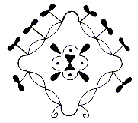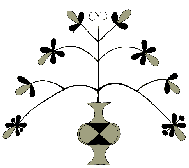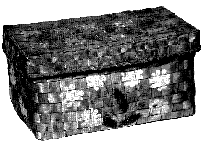

 |
|  |
If we only ask how or when
a basket is made or decorated, we will find out little about the
lives of Nipmuc basket makers. If we ask Who
made Nipmuc baskets? and Why?, we may glimpse
into the lives of the basket makers, and understand a little of
their histories.
Splint baskets therefore
can be about society, people, and history, yet it is often difficult
to realize this when we look at a basket on a pedestal and read
a label with little more than names
(Handsman and McMullen).
 |
The Nipmuc people of southern New England have always been known for their beautifully decorated baskets. Inside a wigwam in 1643, these baskets were used instead of shelves to store all kinds of food and household supplies (Roger Williams 1973). A European traveling In 1674 described these traditional baskets as "very neat and artificial, with the portraitures of birds, beats, fishes and flowers, upon them in colors" (Gookin 1970). Long before European contact, Nipmuc people made baskets from materials including: birchbark, bulrush, cattail, cornhusk, sweetgrass, dogbane, cedarbark.
Nipmucs and other New England
Natives began making baskets out of prepared wood splints in the
1600's. Natives in the Delaware River area may have first learned
the preparation of wood splints for baskets from the Swedes (Snow
1980). Some of the earliest known woodsplint baskets were made
in the mid-1600's by the Iroquois in what is now western New York.
Weaving Nipmuc Splint Baskets
Nipmuc baskets are made from varieties of brown and black ash and white oak. Woodsplints were made from pounding the trunk of a felled tree with a heavy mallet. As the trunk is pounded, the wood starts to separate into thin strips along the tree's natural growth rings. In addition to wood splints, sweetgrass, (sometimes braided) and in much later historic times, twisted Hong Kong grass (an imported cord) were sometimes woven in (Speck 1915).
At first Nipmuc woodsplints were made freehand, without using special knives or gauges. Some basket tools have Native beginnings, such as the crooked knife used to thin woodsplints (and for woodworking in general). Crooked knives originally had a beaver incisor for a blade (Speck 1915), but by the 1600's it had a metal blade, set at an angle, into a wooden handle (Snow 1980).
Nipmucs, like the Mohegans, Pequots, Niantics, and Wampanoags living in region east of the Connecticut River, eventually used a draw knife, (a blade with a handle at either end held with both hands), to shave down woodsplints; so the Nipmuc's basket splints had squared edges. Other Native groups such as the Schaghticoke, Mahican, Paugusset, and Tunxis, living in the western region of southern New England, used the crooked knife (held in one hand) to thin the wood, leaving the splints with tapering, beveled edges.
The baskets of groups living to
either side of the Connecticut River were also woven in different
ways. Nipmucs, in imitation of Pequot basketry, often wove in
a band of narrow-fitting splints or they painted 'bar' designs
that have the same visual effect. Baskets of the western region
of southern New England are noted for the 'porcupine twist'; a
way of twisting the splint weft into a 'curlicue' as it is woven
over the splint warps. The Schaghticoke associate the splint 'curlicue'
with the form of a shell, and similar techniques are used in traditional
porcupine quill work (Speck 1915).
Nipmuc Splint Basket Industry
Traditionally, Nipmuc people would
have make baskets for their own family use, but European colonization
and the fur trade changed the way Nipmucs had to support their
families. With the growing dependence on European goods and a
cash economy through the 1700's and 1800's, many families chose
to earn money making and selling splint baskets.

|
Baskets were more easily made with metal tools that Natives bought from Europeans. Hand gauges, made of small metal blades or wires set into a wooden handle, were used by both Native and European basket makers to cut splints into even widths. As Natives traded more with Europeans, it made the job of preparing splints for baskets easier. By the 1700's when more and more splint baskets were being made, but other traditional craftwork, such as stitched birch bark baskets were becoming quite rare (Turnbaugh & Turnbaugh). Splint baskets were more time and money-saving; a single ash tree could yield a hundred baskets or more, while a birch tree might only produce a dozen (McFeat).
 |
| 1820-1840 ~ Stockade design painted in red lead & blue indigo. |
Carved wooden blocks were eventually used as forms to weave baskets over. By the 1800's many New England Natives used basket blocks, made in all shapes and sizes, to ensure even, standard baskets (Lester). Some baskets were made to resemble acorns, strawberries or ears of corn. Many kinds of baskets were made just for Europeans: 'wall pockets' were hung next to looms and used to store spools of thread, European style woven splint cradles and even tiny woven coverings for European sewing accessories like thimbles, scissors, pincushions.
Many individuals sold their baskets 'door to door' in their local communities; some Nipmucs probably set up arrangements with certain European families to buy their baskets. Using tools like hand gauges and carved blocks saved time and labor, and made it easier to create standardized basket forms; they also helped turn Native basket making into an industry.
Victorian resort areas popping
up in the Northeast in the 1800's changed how splint baskets were
bought and sold. Natives no longer had to travel door to door.
"Instead Indian basket weavers and their families traveled
to the summer resorts and set up shop right there" (McFeat).
Eventually, non-Native middlemen produced wholesale commercial
catalogues for Native-made splint baskets. Mass production for
a European market standardized basket forms, but some families
developed their own unique forms and decorations based on their
individual reputation and for the recognition of their baskets.
Nipmuc Basket Decorations
Baskets are like a signboard where
Nipmucs could communicate their feelings about their surroundings
and their changing existence; they can help us understand the
lives of their makers. Because Nipmucs shared so many aspects
of their culture with neighboring groups, they were probably able
to understand or 'read' the designs on the baskets of others.
Shared basket styles and designs among two groups may mean those
groups view their world in similar ways, or that they have other
social and political connections. If two groups that live right
next to each other have very different designs, it may mean that
they want to set themselves apart, stressing their differences
Stains were swabbed onto the surface of splints with a fiber or cloth wrapped stick, sometimes before and sometimes after the basket was assembled. Usually swabbed baskets are only stained on their exterior. Because dyes are meant to soak completely through woodsplints, splints had to be steeped in dye before they are woven. Paints, or dry pigments mixed with water, oil, size, or whitewash were either applied with brushes, pointed sticks, chewed twigs, or a block stamp made from a piece of carved potato or wood.
Stamped decorations traditionally decorated Native clothing and pottery, but the printed text of the Bible in the 1600's may have inspired block stamp decoration on splint baskets (Speck 1947). As traditional lands were surrendered, some Native communities were destroyed while others were re-assembled, often through the efforts of Christian missionaries, such as John Eliot who established several Nipmuc Praying Towns in Connecticut and Massachusetts in the 1650's.
Although some Natives decorated their baskets with dyed or swabbed splints, Nipmucs and other southeastern New England Natives, usually hand-painted their baskets with specific colors in geometric or floral designs. One Nipmuc woman, Sarah Maria Arnold Cisco, painted her designs on with a home-made cows-hair brush.
Nipmuc baskets were usually painted
in two colors, using combinations of either brown or blue with
orange, pink or red. Of the groups who used painted designs, the
Pequot and Nipmuc were the only ones to use a different color
to fill in their designs. Nipmucs traditionally prepared their
paints from plants. Poke berry made a blue color, cranberries
for red, wild indigo for brown, walnut bark for yellow, and green
was made using both walnut bark and wild indigo. By the 1800's
commercial colors, like laundry bluing and artists pigments sometimes
replaced traditional paints of a similar color.
Nipmucs assigned meaning to the
symbols on their baskets. Shapes like domes, dots, triangles,
leaves, curls and bars were beautifully arranged into designs
we call medallions, strawberries, trails, stockades and vases.
Basket designs represented communities of people, places, territories;
stories of the Nipmuc people.







Medallions
are four domes or other shapes placed around an open central space.
Nipmucs and other Natives had unique ways that they made their
medallions. To many, these medallions represent groups of people,
or family strength. This design is a traditional way to depict
sky-domes that represent the "four directions that guide
the traveler or call the winds" (Tantequidgeon & Fawcett).










Domes,
are made with a simple curved line possibly representing a wigwam.
Domes are often used in medallion designs the way wigwams are
grouped in a village.



Dots,
circles used by themselves or in lines, probably represent
individual people, plants, animals or spiritual forces. In the
center of the medallion design there is a space "that is
of the spirit", which "could be represented as a presence
unseen, or symbolized as a dot, circle, or a combination of these
elements" (Tantequidgeon & Fawcett).




Leaves and
curls were also used just by themselves, with medallions,
or combined with curls to make plants and vines. Leaves may be
a literal symbol of the land.


Trails
are lines of domes, leaves, or curls linked together in a line
or chain. By the late 1800's these trails were not just used as
borders, but as the main figure on baskets. Trails may record
the records kept by Nipmuc families during the 1800's.


 |
Stockades, chains
or lines that delineate design lay-outs, were common on baskets
made before 1840. The chains used in stockades seem to represent
borders on the landscape or between people. Stockade designs showed
how Natives felt about what remained of their traditional territory.
On a Mohegan basket, inside the stockade design (within ancestral
lands), the villages are represented by medallions - while outside
stockade the villages are represented by plants. "The message
was that people would lose their Mohegan identity when they left
the tribal lands" (McMullen). On another Mohegan basket,
medallions were painted both inside and outside the stockade design
and the maker probably felt that "Mohegan people were Mohegan
people wherever they lived" (McMullen).













Strawberries, groups of three
leaves, are an early
design on Nipmuc baskets. Medallion and stockade designs were
often accompanied by strawberries, in groups, alone or on vines,
which probably represented particular people, plants or areas
of land.









Bars,
a series of short parallel lines, may have been originally used
to mimic the band of narrow splints used by Pequot and Nipmuc
basket makers. Later in the historic period, bars are fully incorporated
into basket designs.

Vases, unique
to the Nipmuc people, were first painted during the early 1800's.
Vases were painted on Nipmuc baskets by the Arnold family who
lived at Hassanimisco, near Grafton, Massachusetts. Nipmucs also
began using different colors at this time, blue instead of brown,
either for particular buyers or because that paint was easier
to get. Though older designs were still painted, the floral vase
design had great commercial appeal to European buyers, as well
as traditional meaning to Nipmucs. The 'tree of life' is represented
by flowers made from curls and leaves growing from a medallion-like
vase.
"The construction of a family tradition of vase painting on baskets…, would suggest the growing importance of kin networks in Native American societies" (Handsman & McMullen)

|
| 1840 ~ Covered storage basket with floral design, painted with red lead and laundry bluing. |
Different people interpret the
construction and decoration of Nipmuc splint baskets in different
ways. Scholars, historians, and descendants of the basket makers
have different approaches that may lead to different interpretations
of the same Nipmuc basket. What is clear, however is that these
baskets have much to say about the lives of their makers, the
Nipmuc people, and their struggle to maintain an identity in southern
New England.
Text presented by Tara Prindle,
Program & Events Chairperson for NIAC, Inc. Interpretations
and illustrations of this text are gratefully adapted from the
authoritative source on Native splint basketry: A Key into
the Language of Woodsplint Baskets, edited by Russell
G. Handsman and Ann McMullen, published in 1987 by the American
Archaeological Institute in Washington, CT. The articles authored
therein by Lester, McFeat, McMullen, Tantequidgeon & Fawcett,
and Turnbaugh & Turnbaugh were particularly useful in preparing
this article.

© 1994-1999 Tara Prindle.